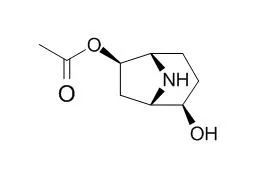| In vitro: |
| Bioorg Med Chem. 2008 Dec 15;16(24):10251-6. | | The absolute configuration plays an important role in muscarinic activity of BGT-A and its analogs.[Pubmed: 19013075] |
METHODS AND RESULTS:
Both enantiomers of 2, 3, and 4, three bioactive analogs of muscarinic agonist BGT-A were prepared respectively and underwent functional studies and radioreceptor binding assays. 6S enantiomers of 2, 3, and 4 showed obvious muscarinic activity, while 6R ones elicited little muscarinic activity by functional studies. Besides, the affinity of 6S enantiomers of 2, 3, and 4 was greatly larger than that of their 6R enantiomers respectively. All these pharmacological results indicated the 6S configuration was beneficial for the active BGT-A analogs to bind with the muscarinic receptors. The finding was in good agreement with our previous SAR study to BGT-A and its active analogs by computational approach.
CONCLUSIONS:
The understanding to the relationship between muscarinic activity and absolute configuration will provide the basis for successive screening of BGT-A analogs as effective muscarinic agonists or antagonists in clinical use. | | Regul. Toxicol. Pharm. 2014, 70(1):349-56 | | Toxicology and the chemical foundation of plants of Erycibe.[Pubmed: 25073109] | Erycibe is a relatively small genus in the family Convolvulaceae with over 10 identified species. Some Erycibe plant species are purportedly toxic at high doses. However, few toxicology studies have been conducted on those species.
METHODS AND RESULTS:
In this study, the toxicity of 40% ethanolic extracts of Erycibeobtusifolia, Erycibeschmidtii, and Erycibeellipptimba was evaluated. E. ellipptimba has been reported to be more toxic due to containing larger amounts of Baogongteng C, an alkaloid with known toxicity. Thus, E. ellipptimba was chosen for further toxicology study here. An HPLC-MS method was developed to identify the main components and determine the percentages of Baogongteng C in total alkaloid of E. ellipptimba (EWA). The toxicity of total alkaloid and Baogongteng C was evaluated and compared.
CONCLUSIONS:
The results indicated that Baogongteng A and Baogongteng C are the major toxic chemical compounds of the Erycibe species tested. The results also suggest EWA is cholinergic. Finally, in a subacute toxicity study of EWA, alterations observed with high dosage suggest that the liver and kidney could be the target organs of toxicity. |
|






 Cell. 2018 Jan 11;172(1-2):249-261.e12. doi: 10.1016/j.cell.2017.12.019.IF=36.216(2019)
Cell. 2018 Jan 11;172(1-2):249-261.e12. doi: 10.1016/j.cell.2017.12.019.IF=36.216(2019) Cell Metab. 2020 Mar 3;31(3):534-548.e5. doi: 10.1016/j.cmet.2020.01.002.IF=22.415(2019)
Cell Metab. 2020 Mar 3;31(3):534-548.e5. doi: 10.1016/j.cmet.2020.01.002.IF=22.415(2019) Mol Cell. 2017 Nov 16;68(4):673-685.e6. doi: 10.1016/j.molcel.2017.10.022.IF=14.548(2019)
Mol Cell. 2017 Nov 16;68(4):673-685.e6. doi: 10.1016/j.molcel.2017.10.022.IF=14.548(2019)